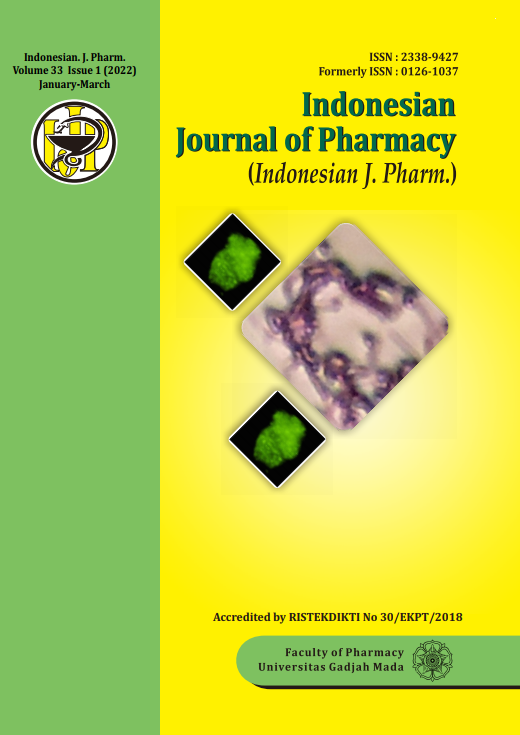Nanoencapsulated formulation of antibacterial metabolites by soil actinomycete, Nocardia sp. TP5 from Tangkuban Perahu Mountain, West Java, Indonesia, with The ionic gelation technique using Na alginate
Abstract
Formulation of nanoencapsulation of antibacterial metabolites from the fermentation of actinomycete strain designed as TP5 has been carried out. Nanoencapsulated formulations performed with Na alginate polysaccharides obtained from brown seaweed can maintain the antibacterial metabolite activity. This study aims to enhance antibacterial activity in nanoencapsulated formulations of antibacterial metabolites with ionic gelation technique using Na alginate and CaCl2. The nanocapsules were prepared by combining the extracellular secondary metabolite Nocardia sp. TP5 with the encapsulation sourced from Na alginate and CaCl2 by ionic gelation technique. The manufacturing methods include fermentation of Nocardia sp. TP5, nanoencapsulated formulation by varying the concentration and ratio of Na alginate, CaCl2, antibacterial metabolites, as well as analysis of nanocapsules. The analysis and characterization of nanoencapsulation using SEM-EDS and PSA included: surface morphology, particle size, chemical constituents, and zeta potential, as well as antibacterial testing against Escherichia coli and Staphylococcus aureus. The results showed that the best-nanoencapsulated formula contains the composition of Na alginate 0.3%, CaCl2 0.06% with a ratio of Na alginate: CaCl2: antibacterial metabolite is 2: 4: 1. The capsule particles formed are evenly distributed over the entire surface with a particle size of 425 nm, zeta potential of -27 mV, and antibacterial activity inhibited the growth of E. coli and S. aureus by 20 and 21 mm, respectively. The variation of the appropriate concentration ratio of Na alginate and CaCl2 greatly affects the uniform nanocapsules size and increases the antibacterial activity.
References
Berdy, J. (2005). Bioactive microbial metabolites: a personal review. The Journal of Antibiotics, 58(1), 1-26.
Cappuccino, J., and Sherman, N. (2005). Microbiology: a laboratory manual 5th edition. USA: The Benjamin/Cummings.
Dhakal, D., Rayamajhi, V., Mishra, R., and Sohng, J. K. (2019). Bioactive molecules from Nocardia: diversity, bioactive and biosynthesis. J. Ind. Microbiol. Biotechnol., 46(3-4), 385-407.
Ezhilarasi, P., Karthik, P., Chanwal, N., and Anandharamakrishnan, C. (2012). Nanoencapsulation techniques for food bioactive components: A review. Journal of Food and Bioprocess Technology, 6(3), 628-647.
Felsenstein, J. (1985). Confidence limits on phylogenies: An approach using the bootstrap. Journal Organism Evolution, 39, 783-789.
Hiraishi, A., Kamagata, Y., and Nakamura, N. (1995). Polymerase chain reaction amplification and restriction fragment length polymorphism analysis of 16S rRNA genes from methanogens. Journal of Fermentation Bioengineering, 79, 523-529.
Holt, J., Krieg, N. R., Sneath, P. H., Staley, J. T., and William, S. T. (1994). Bergey's manual of determinative bacteriology (9th ed). Baltimore, Maryland, USA: The William and Wilkins.
Mishra, M. (2016). Handbook of encapsulation and controlled release: Overview of encapsulation and controlled release. New York: CRC Press.
Mishra, R., Dhakal, D., Han, J. M., Lim, H. N., Jung, H. J., Yamaguchi, T., and Sohng, J. K. (2019). Production of a novel Tetrahydroxynaphthalene (THN) derivative from Nocardia sp. CS682 by metabolic engineering and its bioactivities. Molecules, 24(2), 244.
Oskay, M., Tamer, A. U., and Azery, C. (2004). Antibacterial activity of some Actinomycetes isolated from farming soils of turkey . Afric. J. Biotechnol., 3(9), 441-446.
Pitcher, D. G., Saunders, N. A., and Owen, R. J. (1989). Rapid extraction of bacterial genomic DNA woth guanidium thicyanate. Letters in Applied Microbiology, 8, 151-156.
Rahnemoon, P., Jamab, M. S., Bostan, A., and Mansouri, E. (2021). Nano-encapsulation of pomegranate (Punica granatum L.) peel extract and evaluation of its antimicrobial properties in coated chicken meat. Food Bioscience, 43, 1-8.
Rehm, B. H. (Ed.). (2009). Alginates: Biology and application [Microbiology Monograph] (Vol. 13). Springer-Verlag Berlin Heidelberg.
Saitou, N., and Nei, M. (1987). The neighbor-joining method: A new method for reconstruction phylogenetic tree. Journal Molecular Biology Evolution, 4, 406-425.
Sharma, P., Kalita, M. C., and Thakur, D. (2016). Broad spectrum antimicrobial activity of forest-derived soil Actinomycete, Nocardia sp. PB-52. Frontiers in Microbiology, 7, 347.
Stanbury, P. F., Whitaker, A., and Hall, S. J. (2016). Principles of fermentation technology (3rd ed). Great Britain: Butterworth-Heinemann Publications.
Thompson, J. D., Gibson, T. J., Plewniak, F., and Higgins, D. G. (1997). Clustal X windows interface: Flexible strategies for multiple sequence alignment aided by quality analysis tools. Journal Nucleic Acids Research, 25, 4876-4882.
Vos, P., Faas, M. M., Spasojevic, M., and Sikkema, J. (2010). Encapsulation for preservation of functionally and targeted delivery ofbioactive food components. International Dairy Journal, 20(4), 292-302.
Wardani, I. G., Andayani, D. G., Sukandar, U., Sukandar, E. Y., and Adnyana, I. K. (2013). Study on antimicrobial activity of Nocardia sp. Strain TP1 isolated from Tangkuban Perahu soil, West Java, Indonesia. International Journal of Pharmacy and Pharmaceutical Sciences, 5.
William, S. T., Stalet, J. T., Sneath, P. H., Krieg, N. R., and Holt, J. G. (1994). Bergey's manual of determinative bacteriology (9th edition). USA: The Williams and Wilkins Co., Inc.








